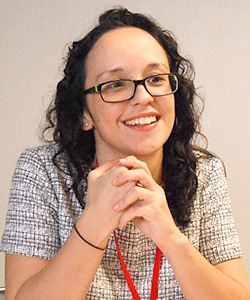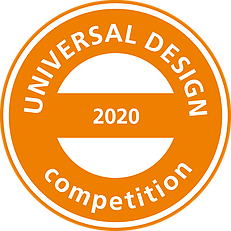Japanese warmth and hospitality will be the foundation of global UD.
2015.08.05 Updated

Fernanda Jordani Barbosa Harada
Visiting Design Fellow, Institute for Human Centered Design: USA
Interviewer: Kazuaki Kitamura (Information Exchange Center / Okamura Corporation)
Interview date: Nov. 12, 2014 PM 12:20-
— What are the characteristics of the Universal Designs (UD) in your country? (Characteristics that the country can be proud of or that have been made widespread)
Fernanda Jordani Barbosa Harada: I am currently living in the United States, but I’m originally from Brazil.
In Brazil, we have some people proclaiming the need for universally designed spaces and products or doing research on this issue and to make changes in policies or environments. However, it is still something restricted to small portions of the population―architects, designers or other related professions.
I think that there is greater understanding of UD itself, but UD is still restricted to big centers such as São Paulo, with small and specific changes. Brazil is a very big country, and these changes should be wider and go beyond just physical changes, to include attitudinal behavior, informational and policies. Fortunately, there are rules (laws) aimed at making spaces more inclusive, and some inspired people defending more universal designed spaces and attitudes (as a whole concept). But, it is still beginning.
From what I know about the United States, they have been looking at the UD subject for longer. Hence they have more understanding and more accessible places with laws that defend people with disabilities against discrimination in all aspects, such as the ADA (American with Disabilities Act).
— In the United States as well, is UD being advanced in accordance to the laws?
Fernanda Jordani Barbosa Harada: The American with Disabilities Act (ADA) was created in 1991, and it has helped to improve understanding accessibility, and this is the baseline of UD. Thus, it has transformed people’s behavior to promote social and physical inclusion.
I cannot see UD only addressed simply by laws, because it is a dynamic thinking process. Rather, it is a framework for designing places, things, information, communication and policy. I hope that it will become a common framework all over the world, and that whatever we build in the future will be based on the concept of inclusion. After all, each person is different from the next.
— What is your impression of UD in Japan in comparison to the United States and Brazil?
Fernanda Jordani Barbosa Harada: This is my first time in Japan. I knew some things from what I read and what I heard from some friends that had already been here. But even being prepared to face good solutions and inclusive spaces I am still surprised with what I have found. Everywhere I went, I saw wonderful solutions, from accessible sidewalks, to signage showing that communication goes beyond using language and includes simple and easy-to-understand pictograms. I was impressed with the good solutions to wayfinding, such what I saw at as the National Museum of Emerging Science and Innovation (Miraikan) next door. Upon entering, I noticed signs on the floor that made it easy to find elevators; I could easily understand where I was. Personally, I thought that it would have been even easier to read the signs if they were displayed in larger sizes, but I thought the concept of the signs was outstanding.
However, we always have things to improve and I think that even in Japan, there is a mix of design that is good and bad. For example, on my first day in Tokyo, I got lost when I was trying to go from my Hotel to visit a temple and park. I was worried about getting lost because I only had three hours and one printed map. All the street signs were all displayed in Japanese, and I had no idea what they are saying. I realized that there were no other means of finding my way around, and the only way not to get lost was counting blocks that I walked so as not to lose myself on the map. Eventually, of course, I lost count of the blocks because I was enjoying the landscape. As a solution for foreigners and tourists, you could install signs in English, for example. If such signs were available, I think it would have been easier to find where I was.
— The Olympic and Paralympic Games will be held in Tokyo in 2020. This is also a theme for this conference, but from the perspective of someone from outside of Japan, please give us your opinions and advice on building global UD toward 2020, including your expectations on city planning and IAUD.
Fernanda Jordani Barbosa Harada: I think it was wonderful to choose the Tokyo Olympics and Paralympics as a theme of this conference. It shows Japan’s dedication to make the country more accessible and welcoming for all.
Making improvements based on UD concepts means that design will reach a wide range of people, providing them confidence, comfort and control. International guests will not only watching the Olympic and Paralympic Games, but they will also be using public transportation, eating and sightseeing. So, thinking about changes, we should analyze all aspects to make a space more inclusive, such as attitudinal behavior, policies, environment, information and communication, with more user-friendly solutions and facilities to welcome outside visitors.
Apart from environmental changes, language is a big issue to be addressed. Good interfaces having some other type of support using something other than language would help and support a big number of tourists involved in different activities around the city.
I think that Japan should take advantage of its enormous human capital: the people of Japan. While here, I have had an amazing opportunity to meet with people in different situations and to experience their great hospitality. Wherever we have gone, people have been kind and received us warmly. In my opinion, Japan’s human capital will greatly assist the country in establishing a global UD by 2020. Human behavior is one of the most difficult levels to change, and it is something that you surely already have here in Japan.
— Thank you very much.
Inquiries
![]() Please make your inquiry here (you will be automatically transferred to the Inquiries page).
Please make your inquiry here (you will be automatically transferred to the Inquiries page).






![[Global Interview 2016] It would be very appreciated if Japan or IAUD could provide and share information and strategies to Europe. 画像](https://www.iaud.net/file/en/sites/3/03bade-1-320x289.jpg)
![[Global Interview 2016] It will be wonderful if the first-ever united Games of the Olympics for non-handicapped people and the Paralympics for handicapped people is realized in Japan in 2020. 画像](https://www.iaud.net/file/en/sites/3/04balaram-1-320x172.jpg)
![[Global Interview 2016] It will be great if the year 2020 becomes a good opportunity for the whole society to raise awareness of design, thereby changing the society for the better. 画像](https://www.iaud.net/file/en/sites/3/01wessler-1-320x279.jpg)
